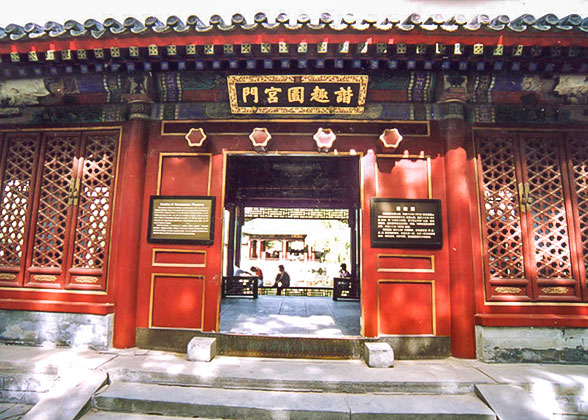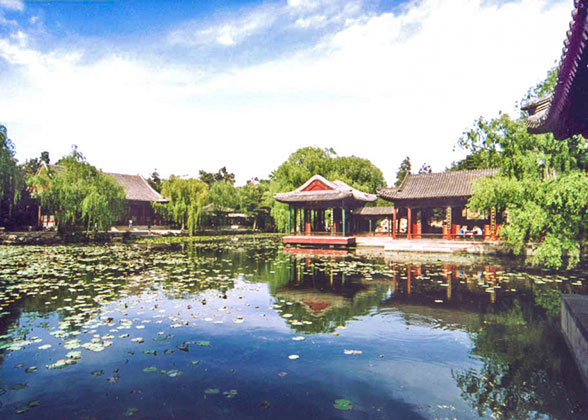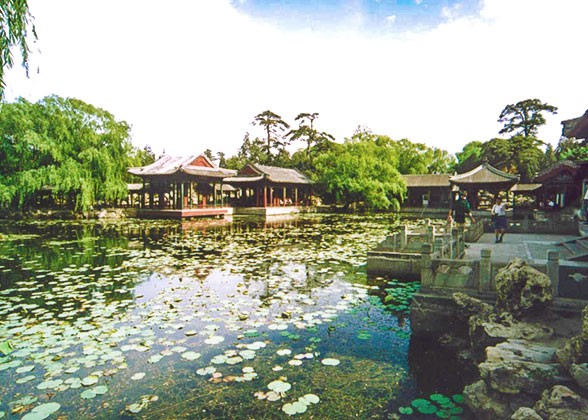Situated beside Kunming Lake, at the bottom of the Eastern side of Longevity Hill, the Garden of Harmonious Interests, with its exquisite design and distinctive layout, is known as the "garden in the gardens" Amongst the gardens of Northern China, its style is the most representative of the classical gardens of Southern China.
When Emperor Qianlong (1711-1799) conducted an inspection of South China in 1751, he developed a great affection for the Jichuangyuan Gardens in Wuxi City, Jiangsu Province, and ordered that a similar garden be built in the Summer Palace and named Huishan Garden. This was the precursor to the Garden of Harmonious Interests. In 1811, it was repaired and given its present name. The garden was rebuilt again in 1893 after its destruction in 1860.
 |
Upon entering the palace gate of Garden of Harmonious Interests, visitors would be greeted by a wonderful panorama. Surrounded by slopes on three sides, with a lotus pond at its centre, the garden was comprised of seven pavilions, five halls, numerous corridors and small bridges, all arranged with profusion and elegance. The scene was mirrored in the pond, which was the focus of the garden's natural surroundings, and released a delicate fragrance of lotus. The garden used to be the fishing site of
Empress Dowager Cixi . It is said that every time Cixi went to fish, eunuchs secretly dived into the water and hung live fish on her hook, to keep her in good spirits.
The garden is remarkable for its eight settings, each with its particular theme. The eight settings are Zaishi Hall, the Momiao Room, Jiuyun Tower, Danbi House, Shuile Pavilion, Zhiyu Bridge, Xunshi Path, and Hanguang Hole. The essence of each of the eight themed settings (or interests) is as follows:
Interest of Seasons
The changing beauty of the garden makes it an attraction for visitors throughout the four seasons of the year. In spring, the willows wave in the breeze, switching on their great charm; in summer, abundant lotuses release a delicious fragrance; in fall, the weeping willows turn the garden into a romantic heaven; in winter, the snows waft down to the trees and pavilions, painting an exquisite landscape.
Interest of Water
Using the falls from the Back Lake, gardeners built the Yuqin Goroge, through which water trickles across the rocks and makes wonderful sounds, like a musical instrument being played. This is also known as the "interest of sound"
Interest of Bridge
Several small bridges span the water, each with their own distinct style. The most notable among them is the Know-the-Fish Bridge, the name of which is derived from an argument about fish between two philosophers of different schools:
Zhuang Zi, one of the philosophers, said: "Look! How happy these fish are!" Hui Zi, the other one, replied: "You are not the fish. How can you know they are happy?" Zhuang Zi replied: "You are not me, how can you know that I know?"
Interest of Calligraphy
There are many examples of calligraphy in the Garden of Harmonious Interests, such as the Xushi Path stele and stone inscription in the Moyun Room.
Interest of Pavilion
In the west corner of the garden stands a pavilion. Viewed from the outside, it gives a visitor the impression that it is a single story high; from the inside, it appears to have two levels. This unusual setting creates an appealing effect of height, and is known as the Interest of Pavilion.
Interest of Painting
Hundreds of paintings in various styles line the corridors in a collection to rival the
Long Gallery . These works, created on the themes of allusions, sceneries, and historical figures, are treasures of art.
Interest of Corridor
Compared to the Long Gallery, the Interest of Corridor is a fascinating collection of twists and turns. Connecting the intricate rooms, it provides visitors a unique chance to view the landscaping of the garden from every angle.
Interest of Imitation
Although the Garden of Harmonious Interests should be a royal garden, it was built in the style of a private one, Jichangyuan Garden. Owing to the skill of the landscapers, any visitor to the garden would feel as if they were in Southern China. Therefore, amongst the glorious and resplendent constructions of the Palace, this garden retains its sense of tranquility and refinement.
- Last updated on Aug. 16, 2024 by Gabby Li -



![]() Next: Suzhou Market Street
Next: Suzhou Market Street![]() Related Link: Summer Palace Travel Tips
Related Link: Summer Palace Travel Tips